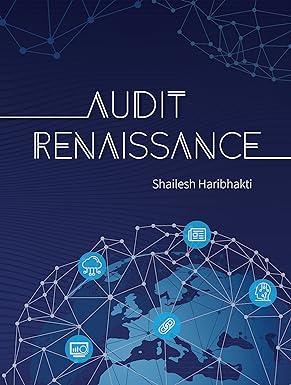Question
4. Suppose KPBs sales manager told the sales staff to start offering 60-day credit terms rather than the 30-day terms now being offered. KPBs competitors
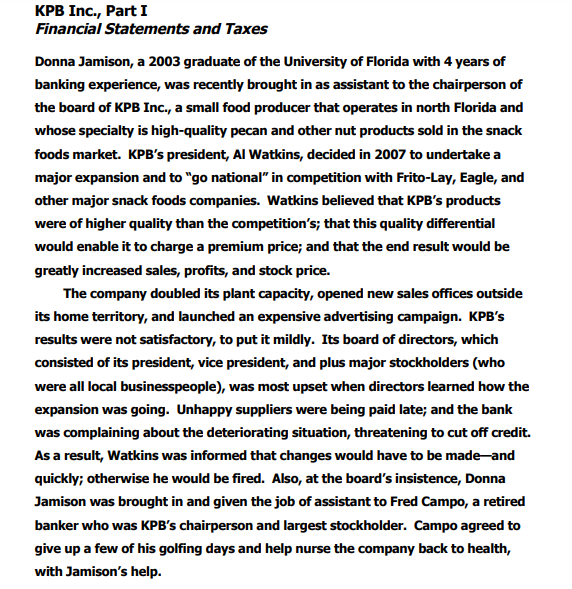
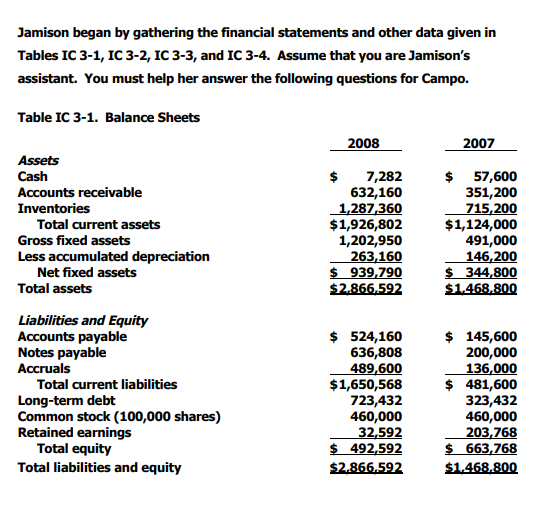
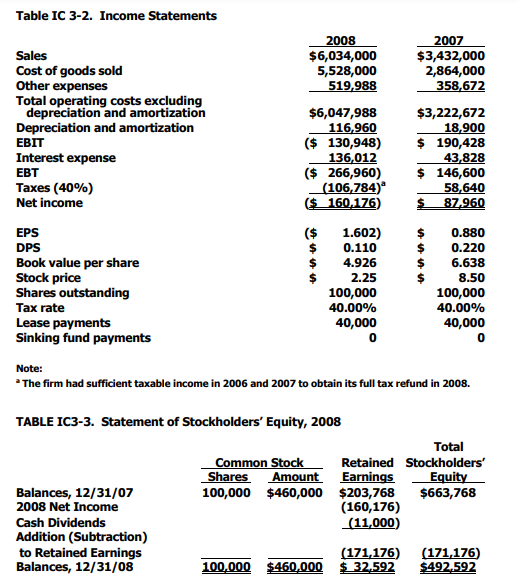
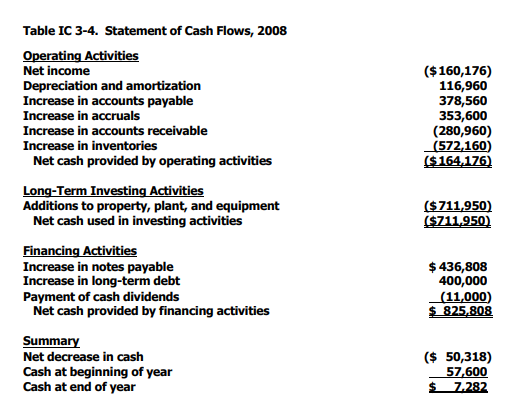
4. Suppose KPBs sales manager told the sales staff to start offering 60-day credit terms rather than the 30-day terms now being offered. KPBs competitors react by offering similar terms, so sales remain constant. What effect would this have on the cash account?
5. Did KPB finance its expansion program with internally generated funds (additions to retained earnings plus depreciation) or with external capital? How does the choice of financing affect the companys financial strength?
6. If KPB starts depreciating fixed assets over 7 years rather than 10 years, would that affect (1) the physical stock of assets, (2) the balance sheet account for fixed assets, (3) the companys reported net income, and (4) the companys cash position? Assume the same depreciation method is used for stockholder reporting and for tax calculations and that the accounting change has no effect on assets physical lives.
KPB Inc., Part I Financial Statements and Taxes Donna Jamison, a 2003 graduate of the University of Florida with 4 years of banking experience, was recently brought in as assistant to the chairperson of the board of KPB Inc., a small food producer that operates in north Florida and whose specialty is high-quality pecan and other nut products sold in the snack foods market. KPB's president, Al Watkins, decided in 2007 to undertake a major expansion and to "go national in competition with Frito-Lay, Eagle, and other major snack foods companies. Watkins believed that KPB's products were of higher quality than the competition's; that this quality differential would enable it to charge a premium price, and that the end result would be greatly increased sales, profits, and stock price. The company doubled its plant capacity, opened new sales offices outside its home territory, and launched an expensive advertising campaign. KPB's results were not satisfactory, to put it mildly. Its board of directors, which consisted of its president, vice president, and plus major stockholders (who were all local businesspeople), was most upset when directors learned how the expansion was going. Unhappy suppliers were being paid late; and the bank was complaining about the deteriorating situation, threatening to cut off credit. As a result, Watkins was informed that changes would have to be made-and quickly; otherwise he would be fired. Also, at the board's insistence, Donna Jamison was brought in and given the job of assistant to Fred Campo, a retired banker who was KPB's chairperson and largest stockholder. Campo agreed to give up a few of his golfing days and help nurse the company back to health, with Jamison's help. Jamison began by gathering the financial statements and other data given in Tables IC 3-1, IC 3-2, IC 3-3, and IC 3-4. Assume that you are Jamison's assistant. You must help her answer the following questions for Campo. Table IC 3-1. Balance Sheets 2008 2007 Assets Cash Accounts receivable Inventories Total current assets Gross fixed assets Less accumulated depreciation Net fixed assets Total assets $ 7,282 632,160 1,287,360 $1,926,802 1,202,950 263,160 $ 939,790 $2.866.592 $ 57,600 351,200 715,200 $1,124,000 491,000 146,200 $ 344,800 $1.468.800 Liabilities and Equity Accounts payable Notes payable Accruals Total current liabilities Long-term debt Common stock (100,000 shares) Retained earnings Total equity Total liabilities and equity $ 524,160 636,808 489,600 $1,650,568 723,432 460,000 32,592 492,592 $2.866.592 $ 145,600 200,000 136,000 $ 481,600 323,432 460,000 203,768 $ 663 768 $1.468.800 Table IC 3-2. Income Statements 2008 $6,034,000 5,528,000 519,988 2007 $3,432,000 2,864,000 358,672 Sales Cost of goods sold Other expenses Total operating costs excluding depreciation and amortization Depreciation and amortization EBIT Interest expense EBT Taxes (40%) Net income $6,047,988 116,960 ($ 130,948) 136,012 ($ 266,960) (106,784) ($ 160,176) $3,222,672 18,900 $ 190,428 43,828 $ 146,600 58,640 $ 87,960 ($ $ $ $ EPS DPS Book value per share Stock price Shares outstanding Tax rate Lease payments Sinking fund payments 1.602) 0.110 4.926 2.25 100,000 40.00% 40,000 $ $ 0.880 0.220 6.638 8.50 100,000 40.00% 40,000 Note: *The firm had sufficient taxable income in 2006 and 2007 to obtain its full tax refund in 2008. TABLE IC3-3. Statement of Stockholders' Equity, 2008 Total Common Stock Retained Stockholders' Shares Amount Earnings Equity Balances, 12/31/07 100,000 $460,000 $203,768 $663,768 2008 Net Income (160,176) Cash Dividends (11,000) Addition (Subtraction) to Retained Earnings (171,176) (171,176) Balances, 12/31/08 100,000 $460.000 $ 32,592 $492,592 ($ 160,176) 116,960 378,560 353,600 (280,960) (572,160) ($ 164,176) Table IC 3-4. Statement of Cash Flows, 2008 Operating Activities Net income Depreciation and amortization Increase in accounts payable Increase in accruals Increase in accounts receivable Increase in inventories Net cash provided by operating activities Long-Term Investing Activities Additions to property, plant, and equipment Net cash used in investing activities Financing Activities Increase in notes payable Increase in long-term debt Payment of cash dividends Net cash provided by financing activities Summary Net decrease in cash Cash at beginning of year Cash at end of year ($ 711,950) ($711,950) $ 436,808 400,000 (11,000) $ 825.808 ($ 50,318) 57,600 $ 7.282 KPB Inc., Part I Financial Statements and Taxes Donna Jamison, a 2003 graduate of the University of Florida with 4 years of banking experience, was recently brought in as assistant to the chairperson of the board of KPB Inc., a small food producer that operates in north Florida and whose specialty is high-quality pecan and other nut products sold in the snack foods market. KPB's president, Al Watkins, decided in 2007 to undertake a major expansion and to "go national in competition with Frito-Lay, Eagle, and other major snack foods companies. Watkins believed that KPB's products were of higher quality than the competition's; that this quality differential would enable it to charge a premium price, and that the end result would be greatly increased sales, profits, and stock price. The company doubled its plant capacity, opened new sales offices outside its home territory, and launched an expensive advertising campaign. KPB's results were not satisfactory, to put it mildly. Its board of directors, which consisted of its president, vice president, and plus major stockholders (who were all local businesspeople), was most upset when directors learned how the expansion was going. Unhappy suppliers were being paid late; and the bank was complaining about the deteriorating situation, threatening to cut off credit. As a result, Watkins was informed that changes would have to be made-and quickly; otherwise he would be fired. Also, at the board's insistence, Donna Jamison was brought in and given the job of assistant to Fred Campo, a retired banker who was KPB's chairperson and largest stockholder. Campo agreed to give up a few of his golfing days and help nurse the company back to health, with Jamison's help. Jamison began by gathering the financial statements and other data given in Tables IC 3-1, IC 3-2, IC 3-3, and IC 3-4. Assume that you are Jamison's assistant. You must help her answer the following questions for Campo. Table IC 3-1. Balance Sheets 2008 2007 Assets Cash Accounts receivable Inventories Total current assets Gross fixed assets Less accumulated depreciation Net fixed assets Total assets $ 7,282 632,160 1,287,360 $1,926,802 1,202,950 263,160 $ 939,790 $2.866.592 $ 57,600 351,200 715,200 $1,124,000 491,000 146,200 $ 344,800 $1.468.800 Liabilities and Equity Accounts payable Notes payable Accruals Total current liabilities Long-term debt Common stock (100,000 shares) Retained earnings Total equity Total liabilities and equity $ 524,160 636,808 489,600 $1,650,568 723,432 460,000 32,592 492,592 $2.866.592 $ 145,600 200,000 136,000 $ 481,600 323,432 460,000 203,768 $ 663 768 $1.468.800 Table IC 3-2. Income Statements 2008 $6,034,000 5,528,000 519,988 2007 $3,432,000 2,864,000 358,672 Sales Cost of goods sold Other expenses Total operating costs excluding depreciation and amortization Depreciation and amortization EBIT Interest expense EBT Taxes (40%) Net income $6,047,988 116,960 ($ 130,948) 136,012 ($ 266,960) (106,784) ($ 160,176) $3,222,672 18,900 $ 190,428 43,828 $ 146,600 58,640 $ 87,960 ($ $ $ $ EPS DPS Book value per share Stock price Shares outstanding Tax rate Lease payments Sinking fund payments 1.602) 0.110 4.926 2.25 100,000 40.00% 40,000 $ $ 0.880 0.220 6.638 8.50 100,000 40.00% 40,000 Note: *The firm had sufficient taxable income in 2006 and 2007 to obtain its full tax refund in 2008. TABLE IC3-3. Statement of Stockholders' Equity, 2008 Total Common Stock Retained Stockholders' Shares Amount Earnings Equity Balances, 12/31/07 100,000 $460,000 $203,768 $663,768 2008 Net Income (160,176) Cash Dividends (11,000) Addition (Subtraction) to Retained Earnings (171,176) (171,176) Balances, 12/31/08 100,000 $460.000 $ 32,592 $492,592 ($ 160,176) 116,960 378,560 353,600 (280,960) (572,160) ($ 164,176) Table IC 3-4. Statement of Cash Flows, 2008 Operating Activities Net income Depreciation and amortization Increase in accounts payable Increase in accruals Increase in accounts receivable Increase in inventories Net cash provided by operating activities Long-Term Investing Activities Additions to property, plant, and equipment Net cash used in investing activities Financing Activities Increase in notes payable Increase in long-term debt Payment of cash dividends Net cash provided by financing activities Summary Net decrease in cash Cash at beginning of year Cash at end of year ($ 711,950) ($711,950) $ 436,808 400,000 (11,000) $ 825.808 ($ 50,318) 57,600 $ 7.282Step by Step Solution
There are 3 Steps involved in it
Step: 1

Get Instant Access to Expert-Tailored Solutions
See step-by-step solutions with expert insights and AI powered tools for academic success
Step: 2

Step: 3

Ace Your Homework with AI
Get the answers you need in no time with our AI-driven, step-by-step assistance
Get Started


